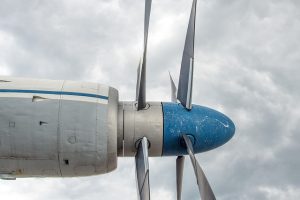
Most airplanes and other aircraft typically use one of two types of engines: turbofan or turboprop. Turbofans are air-breathing jet engines that burn fuel and air to create hot, pressurized exhaust gas. Turboprops, on the other hand, are gas turbine engines that burn fuel and air to spin a blade. While all aircraft propellers convert engine power into thrust, however, there are different types of propellers.
Fixed Pitch
Fixed-pitch propellers are characterized by a static pitch that can’t be changed. Propeller pitch represents the blade’s angle relative to the plane of rotation. It determines how far the propeller can move forward in a single revolution, given no slippage occurs. A fine pitch indicates a small blade angle, whereas a coarse pitch represents a larger angle. Regardless, the angle or pitch of a fixed-pitch propeller can’t be changed.
Ground Adjustable
Ground-adjustable propellers, as the name suggests, are adjustable on the ground. The pitch of ground-adjustable propellers can be increased or decreased on the ground. When compared to fixed-pitch propellers, ground-adjustable propellers are more flexible but require more work to maintain. Prior to takeoff, the pilot or a mechanic may set the pitch. Using the right pitch for a given flight plan will maximize the aircraft’s performance and efficiency.
Controllable Pitch
A step up from ground-adjustable propellers is controllable-pitch propellers. They allow for even more control over the propeller’s pitch than their ground-adjustable counterparts. With controllable-pitch propellers, pilots can change the propeller’s angle or pitch during flight. Controllable-pitch propellers are typically used in commercial airliners and high-performance piston aircraft.
Constant Speed
There are also constant-speed propellers. Constant-speed propellers are technically a type of controllable-pitch propeller. Like all controllable-pitch propellers, the pitch of a constant-speed propeller can be changed during flight. Constant-speed propellers, though, are designed to automatically adjust their pitch. This is done via a device known as a propeller governor or constant speed unit, which regulates oil flow so that the pitch changes to maintain a constant rotational speed.
In Conclusion
The type of propeller used on an aircraft plays a critical role in its overall performance and efficiency. While fixed-pitch propellers offer simplicity, they lack adaptability. Ground-adjustable models provide some flexibility, though they require manual adjustments before flight. Controllable-pitch and constant-speed propellers go a step further, offering in-flight adaptability that enhances performance under varying conditions. With constant-speed systems automatically optimizing pitch, pilots can maintain optimal engine output without manual input.



